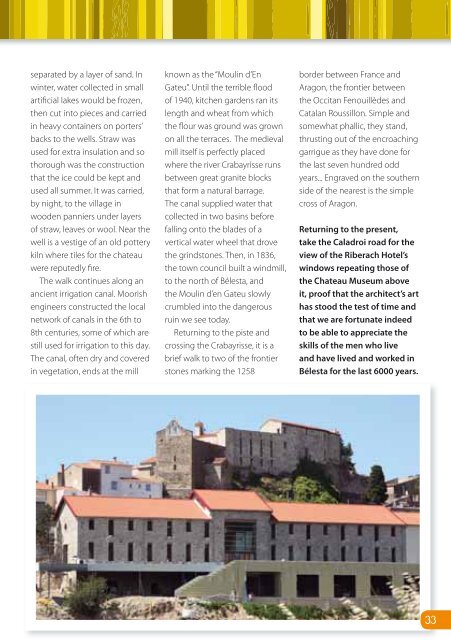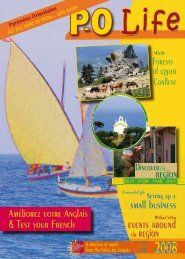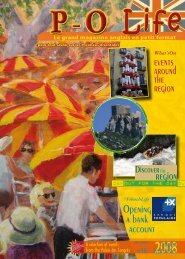P-O Life n°29 (11.8MB) - Anglophone-direct.com
P-O Life n°29 (11.8MB) - Anglophone-direct.com
P-O Life n°29 (11.8MB) - Anglophone-direct.com
You also want an ePaper? Increase the reach of your titles
YUMPU automatically turns print PDFs into web optimized ePapers that Google loves.
separated by a layer of sand. In<br />
winter, water collected in small<br />
artificial lakes would be frozen,<br />
then cut into pieces and carried<br />
in heavy containers on porters’<br />
backs to the wells. Straw was<br />
used for extra insulation and so<br />
thorough was the construction<br />
that the ice could be kept and<br />
used all summer. It was carried,<br />
by night, to the village in<br />
wooden panniers under layers<br />
of straw, leaves or wool. Near the<br />
well is a vestige of an old pottery<br />
kiln where tiles for the chateau<br />
were reputedly fire.<br />
The walk continues along an<br />
ancient irrigation canal. Moorish<br />
engineers constructed the local<br />
network of canals in the 6th to<br />
8th centuries, some of which are<br />
still used for irrigation to this day.<br />
The canal, often dry and covered<br />
in vegetation, ends at the mill<br />
known as the “Moulin d’En<br />
Gateu”. Until the terrible flood<br />
of 1940, kitchen gardens ran its<br />
length and wheat from which<br />
the flour was ground was grown<br />
on all the terraces. The medieval<br />
mill itself is perfectly placed<br />
where the river Crabayrisse runs<br />
between great granite blocks<br />
that form a natural barrage.<br />
The canal supplied water that<br />
collected in two basins before<br />
falling onto the blades of a<br />
vertical water wheel that drove<br />
the grindstones. Then, in 1836,<br />
the town council built a windmill,<br />
to the north of Bélesta, and<br />
the Moulin d’en Gateu slowly<br />
crumbled into the dangerous<br />
ruin we see today.<br />
Returning to the piste and<br />
crossing the Crabayrisse, it is a<br />
brief walk to two of the frontier<br />
stones marking the 1258<br />
border between France and<br />
Aragon, the frontier between<br />
the Occitan Fenouillèdes and<br />
Catalan Roussillon. Simple and<br />
somewhat phallic, they stand,<br />
thrusting out of the encroaching<br />
garrigue as they have done for<br />
the last seven hundred odd<br />
years... Engraved on the southern<br />
side of the nearest is the simple<br />
cross of Aragon.<br />
Returning to the present,<br />
take the Caladroi road for the<br />
view of the Riberach Hotel’s<br />
windows repeating those of<br />
the Chateau Museum above<br />
it, proof that the architect’s art<br />
has stood the test of time and<br />
that we are fortunate indeed<br />
to be able to appreciate the<br />
skills of the men who live<br />
and have lived and worked in<br />
Bélesta for the last 6000 years.<br />
33






